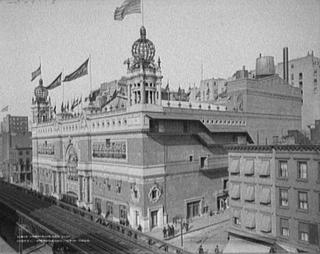The Rise of the Motion Picture Theatre
After the birth of the motion picture in 1895, films were added to the exhibitions of vaudeville and variety stages, and could be seen occasionally in opera houses and Broadway theaters. Thomas Tally's Electric Theater in Los Angeles in 1902 was the first theater in the United States dedicated solely to the exhibition of motion pictures. He sought to provide a wholesome environment for the middle class family. However, the rapid development of small nickelodeon theaters in working class neighborhoods often were designed to appeal primarily to lower class and immigrant audiences. These theaters featured flashing electric lights and blaring phonographs outside, and cheap seats inside with only a piano or sometimes an automatic photoplayer. By 1915, neighborhood theaters were built in many American small towns that offered a wide range of films for men, women and children of all classes. The 1916 Alamo Theatre on Main Street in Bucksport, Maine, restored by the Northeast Historic Film archive, has created a 40-foot mural illustrating the evolution of the motion picture theater, as part of the exhibit "Going to the Movies: A Century of Motion Picture Audiences in Northern New England."
 1905 Hippodrome from LC
1905 Hippodrome from LC
|
The huge New York Hippodrome was built in 1905 by John Gates at a cost of $4 million, with 5200 seats to attract the large middle class audience. Thomas Lamb was one of the first movie palace architects who designed the Regent in 1914, the Strand in 1914, the Rialto in 1916, the Rivoli in 1917, and the Capitol in 1919, and became the main architect for the Loew chain. Samuel "Roxy" Rothapfel was a pioneer of the movie palace in New York, opening the Strand in 1914. His great Roxy Theater in 1927 seated 6215 and became the flagship theater for William Fox. Rapp and Rapp designed for the Balaban and Katz chain, including the Chicago Theater in 1921 and the highly ornamental Paramount in New York in 1926. John Eberson became known for "atmospheric" theaters with ceilings made to look like the open evening sky. One of his first was the Houston Majestic in 1923 and represented an Italian garden inspired by Eberson's upbringing in Vienna. The Anderson Paramount designed by Eberson in 1929 was restored in 1995. Charles Howard Crane designed the "Fabulous Foxes" in Detroit 1928 and St. Louis 1929. Sid Grauman developed theaters with an exotic theme, such as the Egyptian in 1922 and the Chinese in 1927. These great theaters would be the palaces of Hollywood's Golden Age.
Links:
Sources:
- Bowers, Q. David. Nickelodeon Theatres and Their Music. Vestal, N.Y.: Vestal Press, 1986.
- Gomery, Douglas. Shared Pleasures: a History of Movie Presentation in the United States. Madison: University of Wisconsin Press, 1992. 381 p.: ill.; 24 cm. Includes bibliographical references (p. 303-375) and index.
- Hall, Ben M. The Best Remaining Seats; the Story of the Golden Age of the Movie Palace. New York, Bramhall House, 1961.
- Sexton, Randolph Williams and B. F. Betts ; with a foreword by S. L. Rothafel. American Theatres of Today. Vestal, N.Y. : Vestal Press, 1930, 1977.
- Silverman, Stephen M. The Last Remaining Seats: Movie Palaces of Tinseltown. Balcony Press, 1997.
- Stone, Susannah Harris. The Oakland Paramount. Berkeley, CA: Lancaster-Miller Publishers, 1981. 92 p.: ill. (some col.)
- Willman, Chris. "Kings of the Big Screen," Los Angeles Times, June 16, 1996.
revised 9/26/05 by Schoenherr | on reserve | Filmnotes